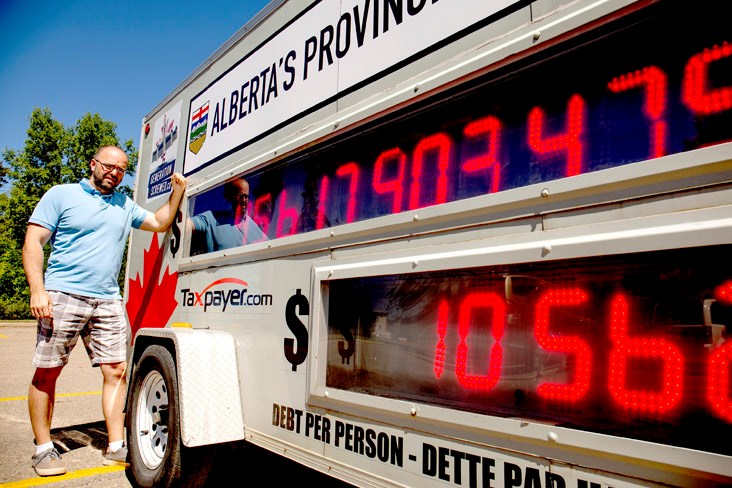Albertans got a chance to witness the provincial debt roll higher last week as a debt clock made a stop in the city.
On July 17, Colin Craig, the Alberta director of the Canadian Taxpayers Federation, stopped in St. Albert with the rolling debt clock to help Albertans visualize the provincial debt in real time.
“It’s a very effective tool to highlight for the public just how out of control spending is right now,” Craig said.
Right now, Alberta is accumulating debt at $344 per second and Craig noted that it is not sustainable and that money will have to eventually be paid back.
Craig said that while debt is not inherently bad, there are moral problems with accruing debt.
It's like a couple going out for dinner and leaving the bill for the kids to pay, Craig said, and that is not fair for the next generation to have to pay back the debt.
Other issues with debt are that it drives up interest costs and debt problems can eventually lead to cuts in essential services.
Barrhead-Morinville-Westlock UCP MLA Glenn van Dijken said that large amounts of debt can stall the economy to a point where you can’t get ahead. The MLA added that the government hasn’t cut spending to reflect the drop in resource revenues since the oil crash.
“I’m very concerned with how this government is continuing to rely on the roller coaster of oil and gas,” van Dijken said.
The MLA wants the government to find efficiencies and more effective ways of delivering services to Albertans.
One of the ways that Craig suggests the government cut its spending is to outsource some of the work to the private sector. He said that this way the government can shop around for the cheapest option while still maintaining service delivery to Albertans.
Another suggestion from Craig is to stretch the province’s four-year capital plan over five years or to downsize the civil service by 10 per cent and reduce government employee compensation by 10 per cent.
In the 2018 budget, the government outlined a path to a balanced budget by 2023 but by then the province will be $96 billion in debt.
Prior to the 2015 election, Alberta’s debt was at $11.9 billion. Three years later, that number had risen to $42.4 billion and is estimated to reach $53.3 billion by the time voters head to the polls next spring.
This year, the province will run a deficit of $8.8 billion with revenues clocking in at $47.9 billion, which is up by $1 billion from last year’s forecast. Expenses will hit $56.2 billion, which is up by $300 million. Total debt sits at $54.2 billion in 2018.
Alberta has projected the deficit to hit $7.9 billion in 2019-20 followed by $7 billion in 2020-21 on the way to balance in 2023-24.
Budget 2018 numbers and projections are all banking on the Line 3 and Trans-Mountain pipelines being constructed and the government provided no alternative projections or contingency plans if those projects stall. The budget projects that both pipelines will be fully operational by 2021.
The debt clock tour started on July 5 and visited more than 20 cities before wrapping up last week.




